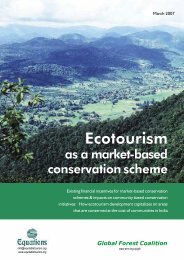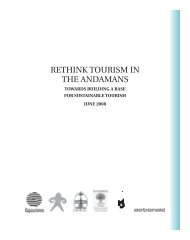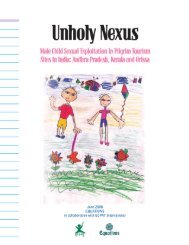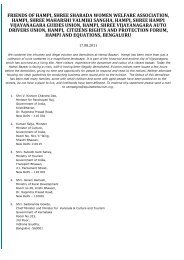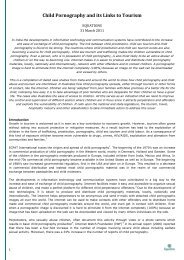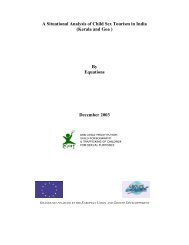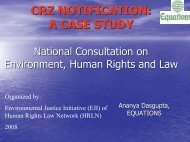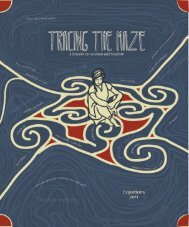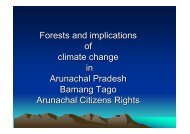Nilgiris Biosphere Reserve - Equitable Tourism Options
Nilgiris Biosphere Reserve - Equitable Tourism Options
Nilgiris Biosphere Reserve - Equitable Tourism Options
Create successful ePaper yourself
Turn your PDF publications into a flip-book with our unique Google optimized e-Paper software.
2.7 <strong>Tourism</strong> Impacts<br />
Identification of Major Impacting Factors<br />
The nature and extent of impact of tourism depends on the intensity of<br />
tourism activity as well as the sensitivity of the impacted ecosystems. This<br />
must be ascertained on the basis of the specifics of the ecosystems in<br />
consideration. However, a few general statements may be made regarding<br />
major impacting factors. Most of the studies show that more severe impacts<br />
of tourism on species and ecosystems arise from the infrastructure and<br />
building activity it involves, rather than from the recreational activities<br />
themselves, as in the case of coastal tourism. In contrast, with nature<br />
tourism, which needs relatively little infrastructure, the activities themselves<br />
are more in the foreground of impacts. In places where sites have already<br />
been selected and developed for tourism, many conflicts are unavoidable<br />
and the impacts can only be diffused to a limited degree during the<br />
operational phase.<br />
Draft Wildlife tourism guidelines, 1997 still remain in the drqjiform.<br />
The Drqfi MoEF guidelines on ecotourism need to made into legalzv<br />
e'!forceable guidelines given the push/or ecotourism projects<br />
The aspects that need to be looked into for determining the impacts of<br />
tourism are:<br />
1. Site choice and de ve lopment<br />
2. Location and operation of tourism related infrastructure<br />
3. Visitor activities<br />
4. I ndire ctly induced effects<br />
<strong>Tourism</strong> related facilities are preferred on attractive landscape sites like<br />
coasts, primarily sandy beaches and dunes, in proximity to lakes and rivers,<br />
and forest areas in the interior, and in the mountains, exposed mountain I hill<br />
tops and slopes. These are often species-rich ecosystems or transitional<br />
zones in between ecosystems, i.e. ecotones. Due to establishment of<br />
tourism related infrastructure and facilities, the species generally found here<br />
are either destroyed or severely affected.<br />
Building materials are often removed from ecosystems for tourism related<br />
constructions, like hotels and roads, in a non-sustainable manner, e.g., as in<br />
the case of extracting the fine sand of beaches, which is used to mix<br />
concrete. This increases the danger of erosion on the beaches, so that in<br />
11 Nilagiris: Fading Glory



